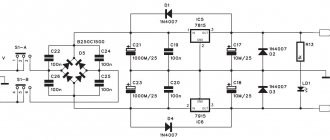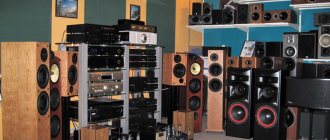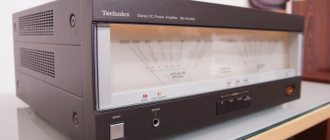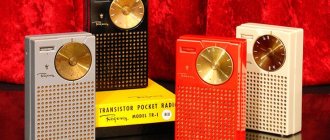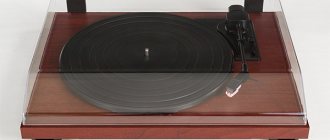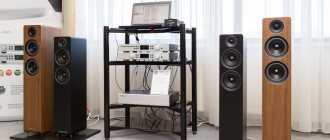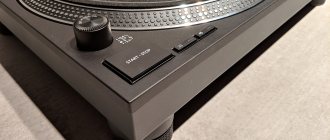Estimated reading time: 9 minutes(s) I would like to tell you a story about selling my Technics SB-LX70 speakers.
Have a good day or evening! The main thing is all the best!
Due to the nature of my work, as well as my hobby, I often come across different people. Some people simply ask what is better - an amplifier or a receiver? Or this question: “what speakers are best to buy for my son to listen to on the computer. Large ones don’t fit on the table, but are floor ones necessary?”
Various questions like this. Some friends once asked, after purchasing a music center, “How to turn it on? Nothing works!” I ask: “For what purpose did you buy it?” – they cannot answer for themselves. Sometimes it happens that I sell equipment through advertisements. There are buyers who “will eat the whole brain,” but won’t buy. Just chat...
Can we imagine ourselves as a buyer in a store? - Yes. Then imagine that you are buying the latest TV model. Well, you really need it! “It’s big, it shows so brightly and clearly! Want!". But you know nothing about its merits.
The seller will try to tell and show you everything, spend half an hour on it and hope that you will say, “Wrap it up!” I’ll take it!” But he will not hear such words. You simply turn around and go to the exit - “Thanks for the story.” The seller receives a percentage of the sale, but this is such a bummer. And he will be very upset. But he is obliged to tell and show, that is his job.
But the story is not about sellers. I want to tell you a little about something else - about selling my Technics SB-LX70 speakers. The buyer was very interested in the purchase, called and asked a lot, and that’s why this story happened. This is what I want to tell you about.
A small retreat
I like to listen to high-quality music, not from desktop computer speakers. From my youth I still have the concepts of good sound and Japanese equipment. That’s why I bought more or less good equipment and acoustics in order to please myself and try to enjoy the sound of the music that the sound engineer put into it when recording this or that musical composition.
I decided to sell my Technics SB-LX70 speakers as they are no longer needed. I had something to listen to my discs on, both equipment and acoustics. After selling these speakers, I was left with a choice - what to listen to. And what remained was not a pair of speakers, but two different pairs, as well as simple acoustics from a mini-home theater - 5.1.
About repair and modification of Technics SB-LX70 acoustics
The speakers were purchased about two years ago in a faulty condition. They came to me from afar, by transport company. In fact, after connecting and listening, a malfunction was revealed - the tweeters did not work. But the seller assured me that everything was fine, everything worked. The exterior is in quite good condition.
But we managed to fix the speakers by replacing the tweeters - they played very well! It was also possible to conduct experiments with crossovers. Quite a lot of experiments have been carried out with the calculation and configuration of several crossovers. The standard crossovers worked fine, we can say that they coped with the task. But after experimenting with calculations, it turned out that factory crossovers are just a toy and they are far from perfect.
Although the Technics SB-LX70 speakers were considered elite in narrow circles of music lovers, in reality they turned out to be “average”. I won't prove anything. I won’t build or show graphs either. They played and played, but with homemade crossovers they began to play even better. Again, all factors are purely individual and for another listener they could be completely different (the eternal debate between music lovers and audiophiles...).
One could leave them, listen and rejoice. They suited me practically in everything. There is such a “disease” - music addiction, but there is a more complex form - audiophilia (the concept itself doesn’t sound very good... but it’s what they came up with). But the complications did not affect me. I consider myself an ordinary music lover. And therefore, I decided that I didn’t need so many sets of acoustics, and I could sell them to another lover of high-quality sound.
A little about what was done. The padding polyester is glued all over the box, on top of the existing “vibration” that cars are glued with. The tweeters have been replaced. The wires to the woofers from the crossover were replaced, just in case. The crossover was replaced first with a homemade one, and then with a ready-made Chinese one, since the standard crossover did not contain anything at all except a few capacitors.
The whole trick is in the lid
The Technics RS-BX70 cassette deck is a rather interesting example of industrial design of those years. There is nothing supernatural about it; it is not a competitor to Nakamichi. This is a regular two-head, two-motor machine with auto reverse, Dolby B/C noise reduction and a motorized cassette cover. Moreover, the main feature of the device is precisely in the lid of the cassette compartment. Honestly, I don't remember this happening on any other deck.
Firstly, there is a recording level indicator on the cover. There is no window in it - instead there is a screen. A rather controversial decision from an operational point of view, since it is not clear what is happening with the cassette. Any maintenance of the tape transport mechanism becomes a very, very difficult matter. Even simple wiping of the capstan is difficult, not to mention adjusting the azimuth of the heads. On the other hand, the appearance is excellent - all screens are in the center, that is, perfect symmetry.
Secondly, the cassette deck is motorized, twice. When I encountered it for the first time, I was slightly puzzled. I opened the cassette deck, inserted the cassette, but it stuck out of the pocket - that is, it was clear that it was not inserted completely and the lid would not close. It turns out that when you press the “Close” button, the cassette is pushed into the pocket, after which the pocket closes. Fantastic! There is nothing like this even on the top Technics cassette decks of those years. Despite the low class of the device, the deck is equipped with a tape calibration function. This is not manual channel-by-channel calibration of the recording level and bias current, but automatic - but still better than nothing.
The sound of the cassette player left an ambivalent impression. On the one hand, all the shortcomings of the format are obvious. On the other hand, some recordings sounded quite decent, albeit with a peculiar smoothing of sharp edges inherent in cassettes. But because of this, so to speak, cassette charm, fans of this format are not transferred. Moreover, cassettes are experiencing a second youth: they are back in fashion and their sales are growing!
Automatic calibration works quite well. The deck was instantly and without problems calibrated to the initial normal and chrome. I tried to make a recording and was pleasantly surprised - Creedence Clearwater Revival “Green River” from a chrome cassette was not much different from the original one. The recording on Normal also came out quite good, but still a little poorer and duller than the original - with a more significant amount of noise.
In turn, the Technics SL-P70 CD player, a budget implementation of the one-bit MASH from Matsushita, left a rather negative impression. Quite a simplified sound, any more or less energetic music like AC/DC “Back In Black” takes on some kind of Rammstein shade with harsh notes. Calmer music - for example, Frank Sinatra's "Moon River" - is reproduced better, but also somewhat angular.
Connecting a higher quality source radically changes the picture, so the CD player is undoubtedly the weak link of this system. This is strange, since the years of release of the set are precisely the beginning of the decline of the cassette era and the peak of the heyday of the popularity of CDs. The device itself, by the way, was not very cheap during the years of its release, costing about $450, and it cannot definitely be classified as a low-budget segment.
There is nothing special to say about the tuner - the device for the Japanese market has a Japanese FM band. Therefore, we can only catch three radio stations on it. Fishes well. But this is an ordinary tuner - however, I did not expect any revelations here. Interestingly, it has a socket for connecting another component, but, unlike the amplifier, only one.
The beginning of the story
By that time, the speakers were already working regularly for the benefit of my hearing with the new crossovers. This happened at a time when the “sheep virus was raging” in the country and movement around the region and the city caused difficulties for some people. Then there is only one bus on the route instead of the usual ten. In general, the taxi doesn’t even come... But the story began before that.
So, on to the story itself. A guy called and asked to listen. “No question - come, I’ll turn it on - you’ll listen!” I came and listened. Everything seems to be working and singing. He left, but promised to return! But he will not return alone, but with a friend. A day later I came to listen with my friend. They listened and listened, turned and turned the tones on the amplifier, moved and moved the speakers apart, sat closer and further away. We examined the appearance and general condition of the speakers.
In short, they gave me a verdict: “Fit for auditions!” They even play the scene very well.” Then there were talks about “the depth of the bass and its clear execution”, “the clarity of the mid frequencies and the absence of distortion in the highs”, “clarity and depth, as well as the transparency of the overall picture”. The result is #fuckingfuck.
All these conversations and reasoning were not with me, they were talking to each other. The entire audition took them about half an hour. I waited patiently. In the end, they decided that they had spent enough time and were ready to go home. Gone... Well, this could be the end of the story about the sale of Technics SB-LX70 acoustics through an advertisement. Here you can also read my thoughts at the beginning of the article - about buyers and sellers.
Everything is serious
Often this is a technique for the domestic Japanese market, but much can be found outside the land of the rising sun. These are not always full-fledged Hi-Fi class components, but they also cannot be called not worthy of attention. Moreover, some of these devices are quite capable of competing with their full-size counterparts. Today we will talk about one such kit produced in 1994, intended for the Japanese domestic market - Technics 70.
The set has a strict, uncompromising appearance that does not allow any hint of frivolity. The shiny front panels of all components are made of extruded aluminum - a metal of such thickness that other high-end equipment can envy. The housing covers are also made of aluminum, unlike most devices, in which they are just painted steel. Even the Technics supertops of those years did not have this. It immediately becomes clear that you are not dealing with a budget system.
The kit includes four components: a Technics SU-A70 amplifier, a Technics RS-BX70 cassette deck, a Technics SL-P70 CD player and a Technics ST-GT70 AM/FM tuner. It was not necessary to purchase all four blocks: you could buy the components separately or purchase one of the ready-made options:
• CD + amplifier + 2-way speakers;
• CD + amplifier + 3-way acoustics;
• CD + amplifier + cassette deck + tuner + 2-way acoustics;
• CD + amplifier + cassette deck + tuner + 3-way acoustics.
The price of the most expensive set exceeded $2,000, and the most budget option cost $1,500! And this was in the mid-90s, when the dollar was completely different than it is now!
All components are controlled from a common remote control, with each component having its own IR signal receiver. However, you can only turn on the amplifier from the remote control - the remaining components have to be turned on by pressing a button on the front panel.
As I already mentioned, the system was equipped with two types of acoustics: the first option was the classic two-way bookshelf speakers Technics SB-M20, and the second option, despite the similar appearance, was much more advanced. Cheaper, two-way speakers are nothing special. But we can’t help but tell you more about the three-way Technics SB-M300. I hope to get my hands on these speakers someday, because the acoustics are extraordinary, at least from the point of view of technical solutions.
The acoustics are three-way and have four speakers, with two bass drivers located inside the body and hidden from view. One is located behind the front panel, the second is on the rear wall and is covered with a passive reflector. This design was designed to provide excellent bass response with very modest dimensions.
Continuation of the story about SB-LX70
But there is a continuation! My reaction to how I spent that half hour was mixed. I was ready to send them in a certain direction “behind their backs,” but I didn’t do it. Either my upbringing didn’t allow it, or I was just in a normal mood. He sighed and put the speaker in the corner of the room.
Two weeks have passed. After this listening, there were not many calls at all - probably about six. Yes... so many calls in two weeks! My thoughts – “I’ll probably never sell them! And if this is the case, then we can continue experiments with these speakers.” And he continued. I bought a new crossover for car acoustics on a well-known website, at a reasonable price. Approximately the parameters suitable for the SB-LX70 speakers. At this point I didn’t think much about the results. Come what may!
Another two weeks passed. “pasta virus is raging” across the country. Got these crossovers. Put. Well, I didn’t notice much of a difference by ear. And then I decided to install my own “crossovers” and removed the synthetic padding. In short, it turned out that I returned the speakers to almost factory condition. An exception is the vibroplast, which was installed even before I bought the speakers and the new tweeters I installed.
Suddenly, a call. The same guy who came to listen earlier calls. By the way, there were no more auditions at all; everyone wanted to negotiate a lower price over the phone and take it as is. But on the phone: “We’ll come again to listen to the speakers!” But we want to listen to the speakers through our amplifier.” What news! Of course I agreed.
We arrived, unwrapped our wires and amplifier and began to listen. And they listened loudly and quietly, and again they turned the timbres either negative or positive. Having fun like adults.
The first time I told them the whole history of the speakers and their modifications, they then did not say anything about my modifications, as if they had not heard. And then the buyer began to tell me a new smart idea. He says: “..here is a modified crossover, or a home-made one, it doesn’t play like the factory one - after all, they weren’t fools in Japan who built these acoustics! But still, I’m completely satisfied.”
I didn’t tell them anything, that everything “unnecessary” had already been removed from the speakers and they were practically stock. He remained silent and did not argue. He only asked: “Is everything satisfactory to you? Do you like the sound? Are you buying? I won’t accept any complaints later – one hundred percent! I won’t give a guarantee, but I can be sure that with proper and careful use they can work for a long time.”
They, as is expected when trading, began to demand a discount on gasoline. Also, they asked me to take care of the abrasions on the cases (yes, the appearance is not “from the factory”, but they are already wow years old!). We bargained a little. The amount turned out to be almost the same as what I paid for them almost two years ago. Taking into account my experiences, experiments, experience and knowledge gained, I agreed and said goodbye to the columns.
A big heart
The amplifier is the heart of any audio system. In our case, this is the Technics SU-A70. Although the series was released in the mid-90s, the design clearly gravitates towards the late 80s and early 90s. Chopped shapes and a huge volume control knob located in the middle of the front panel refer us to monsters like the Technics SU-V900 or Technics SU-MA10. The amplifier clearly wants to appear bigger and cooler than it is. By the way, it turns out quite well! The volume control knob is machined from aluminum, but the rest of the knobs are plastic - they decided to save money on them.
The device is built on MOSFET assemblies, as the inscription on the front panel proudly tells us. Similar MOSFET assemblies, but with higher power, were used by Matsushita in their famous budget switches Technics SE-A1000. These assemblies are powered by two 8,200 µF capacitors and a rather serious R-Core transformer, occupying about a quarter of the case volume. This type of transformer was used in some Technics amplifiers to reduce interference, but it was not widely used.
Technics SU-A70 has good switching capabilities - many inputs, built-in phono stage, two recording outputs. But for connecting speaker systems there is only one pair of connectors - connecting a second pair of speakers is not expected. There are switchable inputs and outputs for working with the equalizer, which is very convenient: press a button and the equalizer is turned off, no need to climb to the back wall and fiddle with wires.
It is surprising that there is no equalizer or processor of this form factor not only in this line, but also in principle from the manufacturer. Using the buttons on the front panel, you can turn off not only the equalizer, but also the acoustics. The need for this button is explained by the fact that when you connect headphones to the jack, there is no automatic shutdown of the acoustics.
There are also two sockets on the rear panel of the amplifier for connecting other components. Both of them are turned off if the amplifier is turned off - that is, put into standby mode. Sockets are a good solution, especially in our country, since the device operates on a voltage of 100 V. But you need to take into account that connecting a serious consumer, as practice has shown, does not have the best effect on the sound. You feel a lack of power - the sound becomes completely flat and inexpressive.
I would like to note a couple of controversial decisions. The first is the absence of an input selector knob. Instead, there are two buttons located under the volume control. I would venture to suggest that this was done for the sake of design - for better, so to speak, symmetry of appearance. The second is the location of the terminals for connecting acoustics. It is not classic, when the left channel is connected to the left pair of terminals, and the right channel to the right pair. Everything is different here: one pair of terminals is located above the other. Not the best solution from an ergonomic point of view.
There wasn’t a single option for native acoustics within walking distance, so I connected very large three-way bookshelf speakers—JBL LS40—to the amplifier.
The amplifier demonstrates good acoustic control, drums and bass lines are well defined - I would even say that they dominate the sound a little. But the middle leaves much to be desired. Although the amplifier does not dump it into mush, a certain failure is still felt, a lack of the air so beloved by everyone. The upper frequencies are softened, but not hollow and sound very comfortable.
Heavy energetic things work well when the transfer of drive is important - for example, Metallica's album “...And Justice for All”. And something refined, when a jeweler’s rendering of overtones is required, is reproduced somewhat blurry. At all reasonable volume levels, I did not notice that the amplifier was unable to cope with its task. Perhaps it did not fully reveal the acoustics, but it worked quite well.


